Data Forensics: IoT Architectures, Impacts, and Forensics Challenges
VerifiedAdded on 2022/10/06
|6
|1137
|27
Report
AI Summary
This report examines the integration of Internet of Things (IoT) in digital forensics, focusing on its impact on enhancing forensic processes. It addresses key research questions concerning IoT infrastructure used in digital forensics, the impacts of IoT, and associated challenges. A literature review explores different architectural models, including device-level, network, and cloud forensics, as well as models incorporating forensic protection layers. The report highlights the impact of IoT on identification, preservation, analysis, and presentation of digital evidence, while also acknowledging issues such as performance and aggregation that can lead to data breaching and privacy concerns. The data analysis methodology employs secondary research, utilizing peer-reviewed journals to ensure data authenticity and accuracy. The report concludes that IoT offers significant potential for evidence gathering but requires careful consideration of its heterogeneous nature and associated challenges to ensure effective digital forensics practices. Desklib provides this and other solved assignments to aid students in their studies.
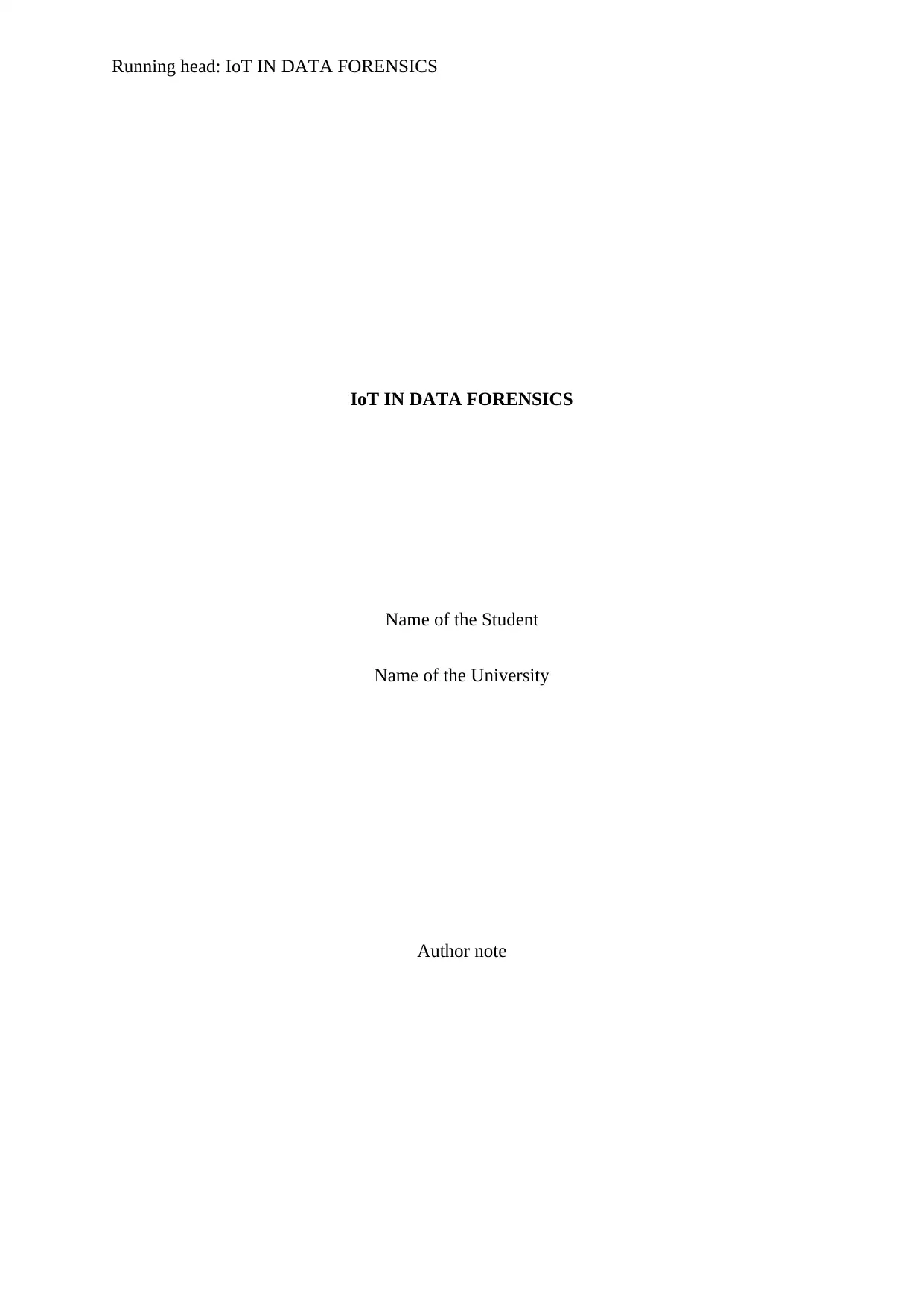
Running head: IoT IN DATA FORENSICS
IoT IN DATA FORENSICS
Name of the Student
Name of the University
Author note
IoT IN DATA FORENSICS
Name of the Student
Name of the University
Author note
Paraphrase This Document
Need a fresh take? Get an instant paraphrase of this document with our AI Paraphraser
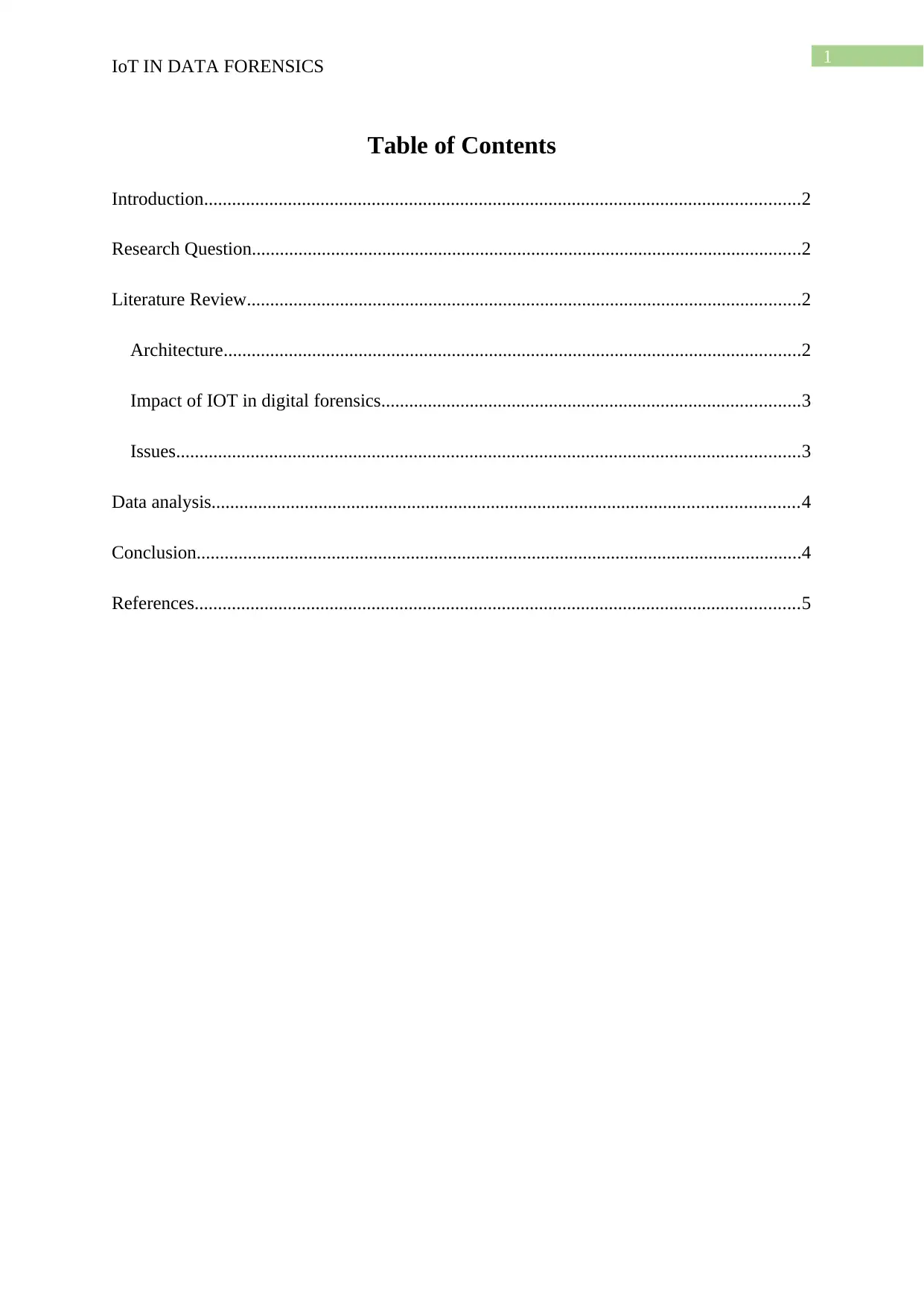
1
IoT IN DATA FORENSICS
Table of Contents
Introduction................................................................................................................................2
Research Question......................................................................................................................2
Literature Review.......................................................................................................................2
Architecture............................................................................................................................2
Impact of IOT in digital forensics..........................................................................................3
Issues......................................................................................................................................3
Data analysis..............................................................................................................................4
Conclusion..................................................................................................................................4
References..................................................................................................................................5
IoT IN DATA FORENSICS
Table of Contents
Introduction................................................................................................................................2
Research Question......................................................................................................................2
Literature Review.......................................................................................................................2
Architecture............................................................................................................................2
Impact of IOT in digital forensics..........................................................................................3
Issues......................................................................................................................................3
Data analysis..............................................................................................................................4
Conclusion..................................................................................................................................4
References..................................................................................................................................5
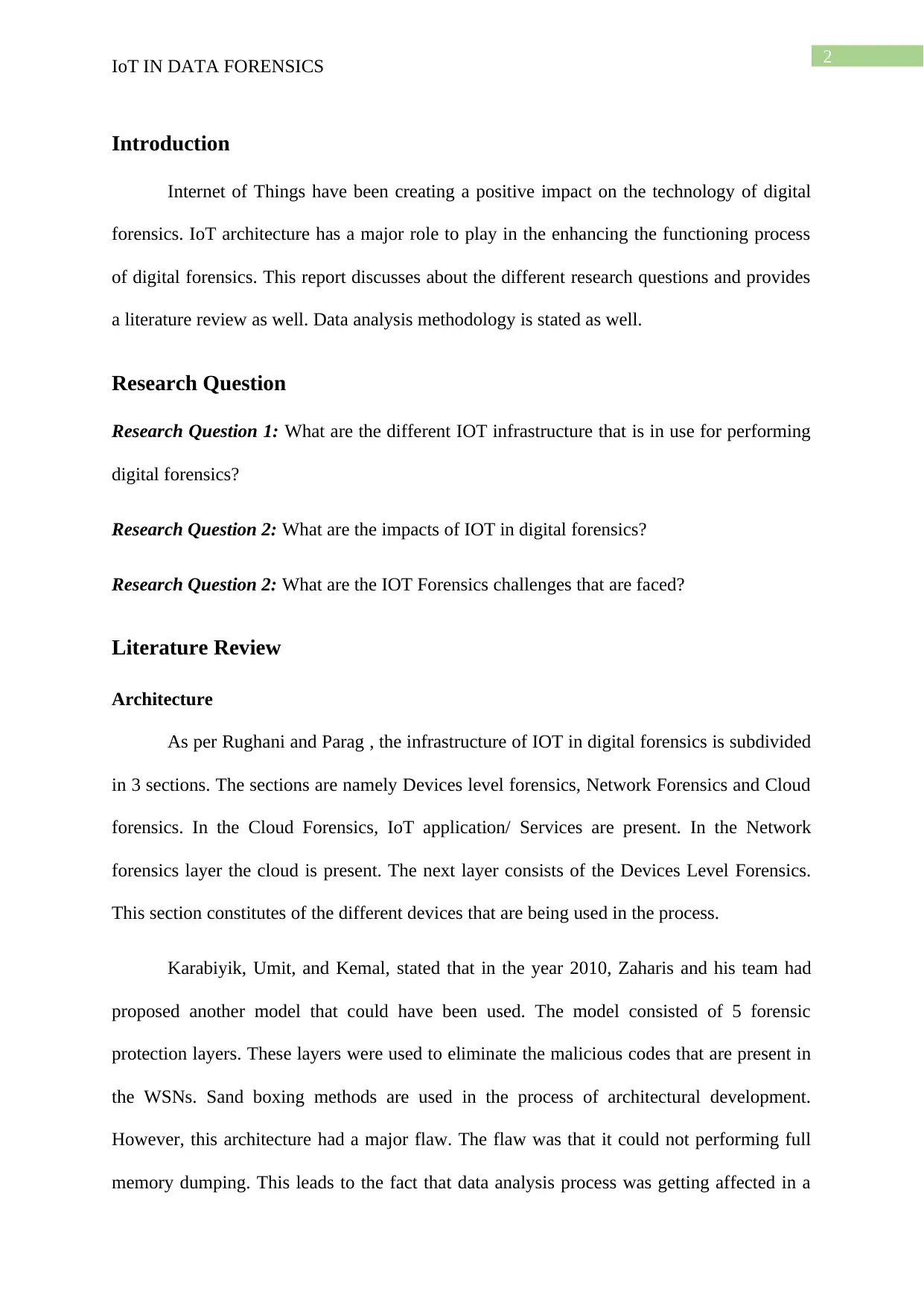
2
IoT IN DATA FORENSICS
Introduction
Internet of Things have been creating a positive impact on the technology of digital
forensics. IoT architecture has a major role to play in the enhancing the functioning process
of digital forensics. This report discusses about the different research questions and provides
a literature review as well. Data analysis methodology is stated as well.
Research Question
Research Question 1: What are the different IOT infrastructure that is in use for performing
digital forensics?
Research Question 2: What are the impacts of IOT in digital forensics?
Research Question 2: What are the IOT Forensics challenges that are faced?
Literature Review
Architecture
As per Rughani and Parag , the infrastructure of IOT in digital forensics is subdivided
in 3 sections. The sections are namely Devices level forensics, Network Forensics and Cloud
forensics. In the Cloud Forensics, IoT application/ Services are present. In the Network
forensics layer the cloud is present. The next layer consists of the Devices Level Forensics.
This section constitutes of the different devices that are being used in the process.
Karabiyik, Umit, and Kemal, stated that in the year 2010, Zaharis and his team had
proposed another model that could have been used. The model consisted of 5 forensic
protection layers. These layers were used to eliminate the malicious codes that are present in
the WSNs. Sand boxing methods are used in the process of architectural development.
However, this architecture had a major flaw. The flaw was that it could not performing full
memory dumping. This leads to the fact that data analysis process was getting affected in a
IoT IN DATA FORENSICS
Introduction
Internet of Things have been creating a positive impact on the technology of digital
forensics. IoT architecture has a major role to play in the enhancing the functioning process
of digital forensics. This report discusses about the different research questions and provides
a literature review as well. Data analysis methodology is stated as well.
Research Question
Research Question 1: What are the different IOT infrastructure that is in use for performing
digital forensics?
Research Question 2: What are the impacts of IOT in digital forensics?
Research Question 2: What are the IOT Forensics challenges that are faced?
Literature Review
Architecture
As per Rughani and Parag , the infrastructure of IOT in digital forensics is subdivided
in 3 sections. The sections are namely Devices level forensics, Network Forensics and Cloud
forensics. In the Cloud Forensics, IoT application/ Services are present. In the Network
forensics layer the cloud is present. The next layer consists of the Devices Level Forensics.
This section constitutes of the different devices that are being used in the process.
Karabiyik, Umit, and Kemal, stated that in the year 2010, Zaharis and his team had
proposed another model that could have been used. The model consisted of 5 forensic
protection layers. These layers were used to eliminate the malicious codes that are present in
the WSNs. Sand boxing methods are used in the process of architectural development.
However, this architecture had a major flaw. The flaw was that it could not performing full
memory dumping. This leads to the fact that data analysis process was getting affected in a
⊘ This is a preview!⊘
Do you want full access?
Subscribe today to unlock all pages.

Trusted by 1+ million students worldwide
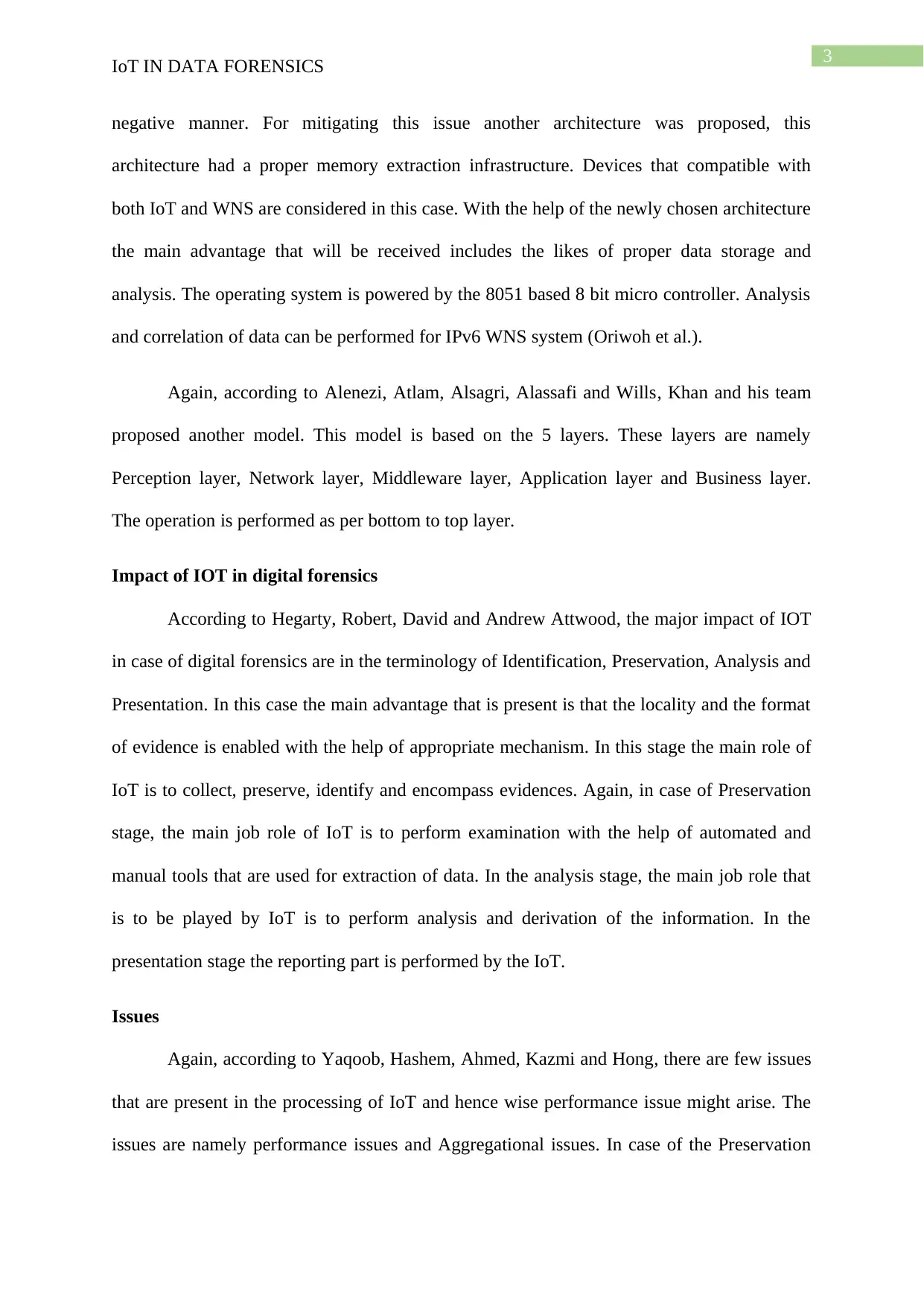
3
IoT IN DATA FORENSICS
negative manner. For mitigating this issue another architecture was proposed, this
architecture had a proper memory extraction infrastructure. Devices that compatible with
both IoT and WNS are considered in this case. With the help of the newly chosen architecture
the main advantage that will be received includes the likes of proper data storage and
analysis. The operating system is powered by the 8051 based 8 bit micro controller. Analysis
and correlation of data can be performed for IPv6 WNS system (Oriwoh et al.).
Again, according to Alenezi, Atlam, Alsagri, Alassafi and Wills, Khan and his team
proposed another model. This model is based on the 5 layers. These layers are namely
Perception layer, Network layer, Middleware layer, Application layer and Business layer.
The operation is performed as per bottom to top layer.
Impact of IOT in digital forensics
According to Hegarty, Robert, David and Andrew Attwood, the major impact of IOT
in case of digital forensics are in the terminology of Identification, Preservation, Analysis and
Presentation. In this case the main advantage that is present is that the locality and the format
of evidence is enabled with the help of appropriate mechanism. In this stage the main role of
IoT is to collect, preserve, identify and encompass evidences. Again, in case of Preservation
stage, the main job role of IoT is to perform examination with the help of automated and
manual tools that are used for extraction of data. In the analysis stage, the main job role that
is to be played by IoT is to perform analysis and derivation of the information. In the
presentation stage the reporting part is performed by the IoT.
Issues
Again, according to Yaqoob, Hashem, Ahmed, Kazmi and Hong, there are few issues
that are present in the processing of IoT and hence wise performance issue might arise. The
issues are namely performance issues and Aggregational issues. In case of the Preservation
IoT IN DATA FORENSICS
negative manner. For mitigating this issue another architecture was proposed, this
architecture had a proper memory extraction infrastructure. Devices that compatible with
both IoT and WNS are considered in this case. With the help of the newly chosen architecture
the main advantage that will be received includes the likes of proper data storage and
analysis. The operating system is powered by the 8051 based 8 bit micro controller. Analysis
and correlation of data can be performed for IPv6 WNS system (Oriwoh et al.).
Again, according to Alenezi, Atlam, Alsagri, Alassafi and Wills, Khan and his team
proposed another model. This model is based on the 5 layers. These layers are namely
Perception layer, Network layer, Middleware layer, Application layer and Business layer.
The operation is performed as per bottom to top layer.
Impact of IOT in digital forensics
According to Hegarty, Robert, David and Andrew Attwood, the major impact of IOT
in case of digital forensics are in the terminology of Identification, Preservation, Analysis and
Presentation. In this case the main advantage that is present is that the locality and the format
of evidence is enabled with the help of appropriate mechanism. In this stage the main role of
IoT is to collect, preserve, identify and encompass evidences. Again, in case of Preservation
stage, the main job role of IoT is to perform examination with the help of automated and
manual tools that are used for extraction of data. In the analysis stage, the main job role that
is to be played by IoT is to perform analysis and derivation of the information. In the
presentation stage the reporting part is performed by the IoT.
Issues
Again, according to Yaqoob, Hashem, Ahmed, Kazmi and Hong, there are few issues
that are present in the processing of IoT and hence wise performance issue might arise. The
issues are namely performance issues and Aggregational issues. In case of the Preservation
Paraphrase This Document
Need a fresh take? Get an instant paraphrase of this document with our AI Paraphraser
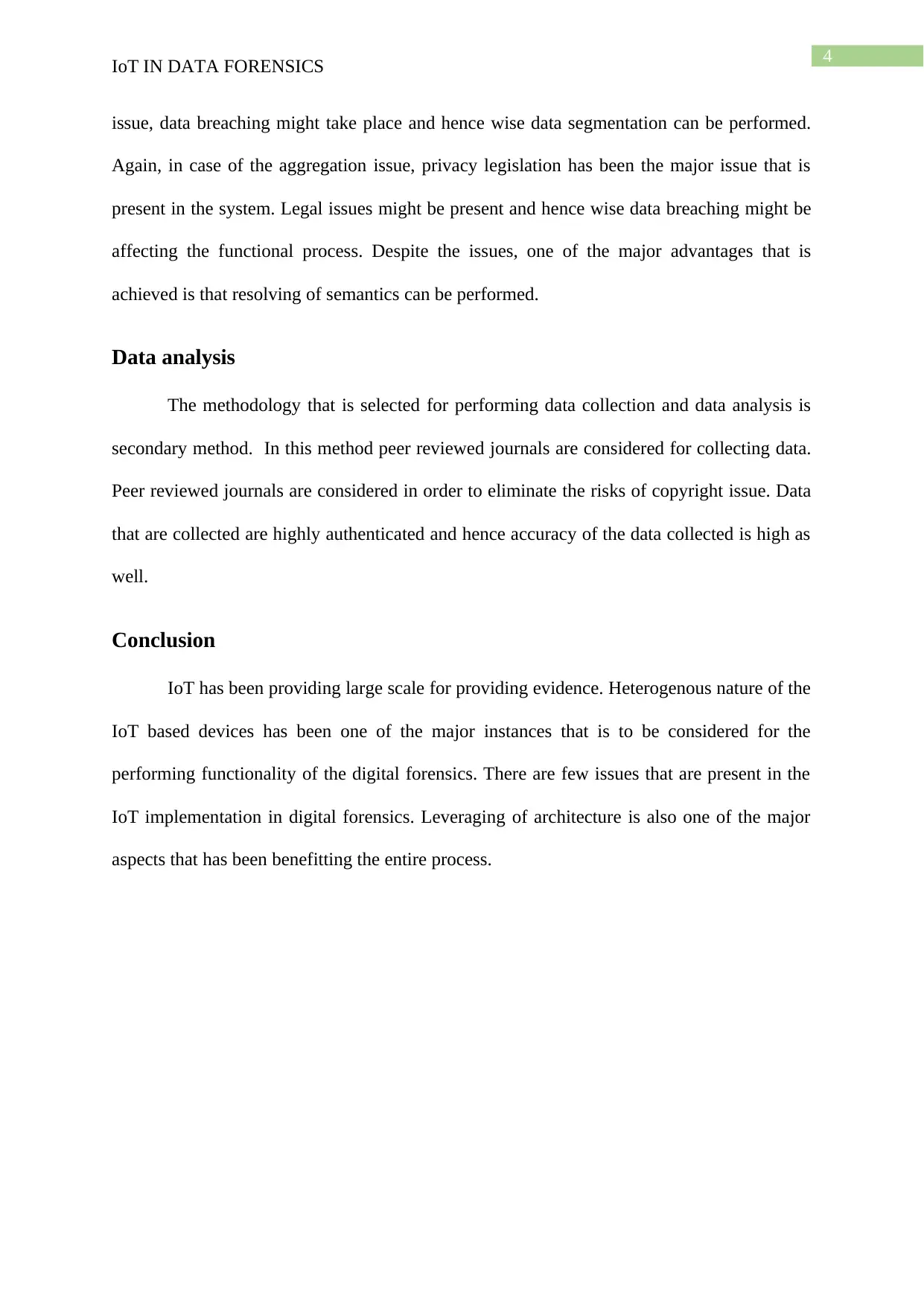
4
IoT IN DATA FORENSICS
issue, data breaching might take place and hence wise data segmentation can be performed.
Again, in case of the aggregation issue, privacy legislation has been the major issue that is
present in the system. Legal issues might be present and hence wise data breaching might be
affecting the functional process. Despite the issues, one of the major advantages that is
achieved is that resolving of semantics can be performed.
Data analysis
The methodology that is selected for performing data collection and data analysis is
secondary method. In this method peer reviewed journals are considered for collecting data.
Peer reviewed journals are considered in order to eliminate the risks of copyright issue. Data
that are collected are highly authenticated and hence accuracy of the data collected is high as
well.
Conclusion
IoT has been providing large scale for providing evidence. Heterogenous nature of the
IoT based devices has been one of the major instances that is to be considered for the
performing functionality of the digital forensics. There are few issues that are present in the
IoT implementation in digital forensics. Leveraging of architecture is also one of the major
aspects that has been benefitting the entire process.
IoT IN DATA FORENSICS
issue, data breaching might take place and hence wise data segmentation can be performed.
Again, in case of the aggregation issue, privacy legislation has been the major issue that is
present in the system. Legal issues might be present and hence wise data breaching might be
affecting the functional process. Despite the issues, one of the major advantages that is
achieved is that resolving of semantics can be performed.
Data analysis
The methodology that is selected for performing data collection and data analysis is
secondary method. In this method peer reviewed journals are considered for collecting data.
Peer reviewed journals are considered in order to eliminate the risks of copyright issue. Data
that are collected are highly authenticated and hence accuracy of the data collected is high as
well.
Conclusion
IoT has been providing large scale for providing evidence. Heterogenous nature of the
IoT based devices has been one of the major instances that is to be considered for the
performing functionality of the digital forensics. There are few issues that are present in the
IoT implementation in digital forensics. Leveraging of architecture is also one of the major
aspects that has been benefitting the entire process.
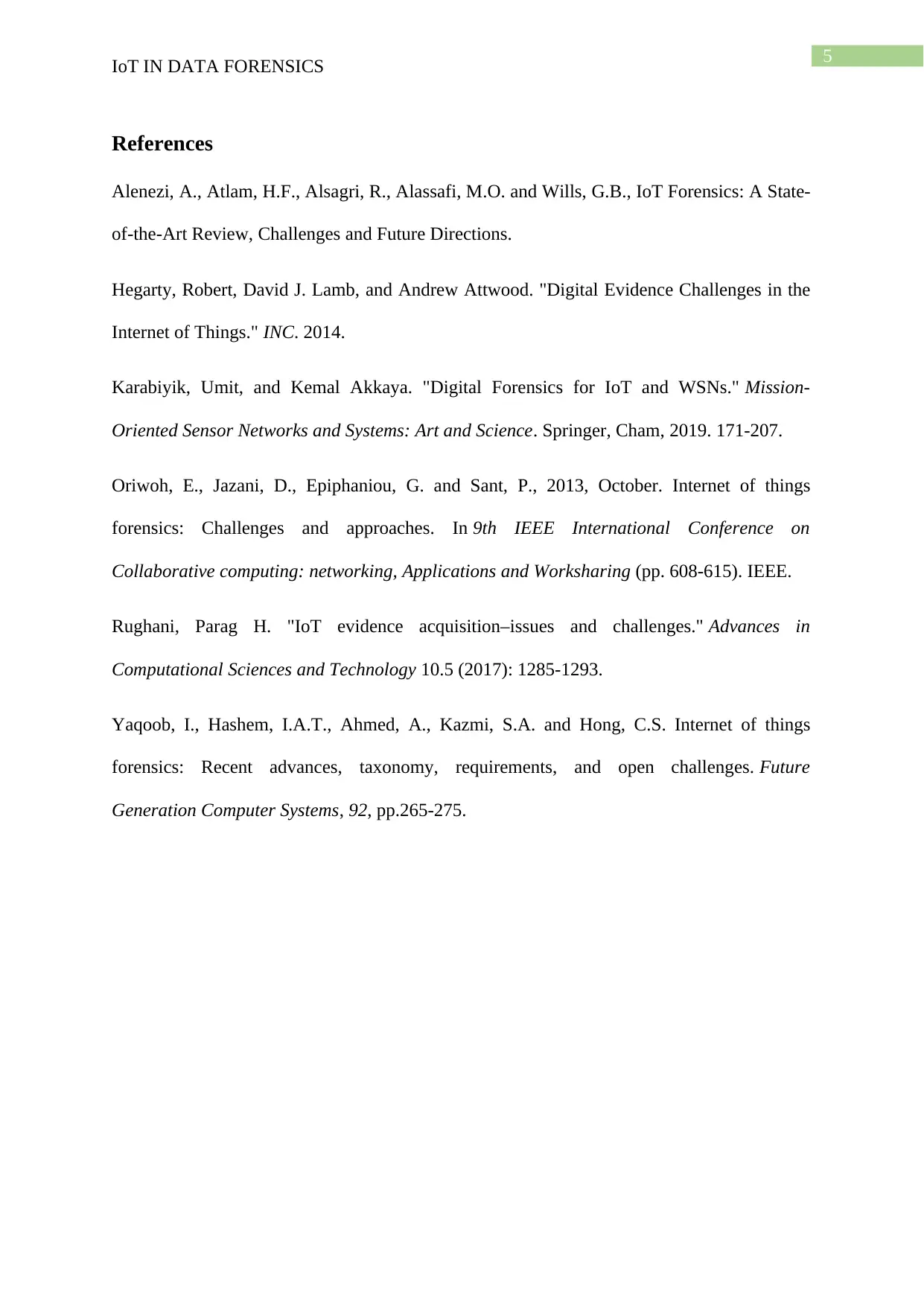
5
IoT IN DATA FORENSICS
References
Alenezi, A., Atlam, H.F., Alsagri, R., Alassafi, M.O. and Wills, G.B., IoT Forensics: A State-
of-the-Art Review, Challenges and Future Directions.
Hegarty, Robert, David J. Lamb, and Andrew Attwood. "Digital Evidence Challenges in the
Internet of Things." INC. 2014.
Karabiyik, Umit, and Kemal Akkaya. "Digital Forensics for IoT and WSNs." Mission-
Oriented Sensor Networks and Systems: Art and Science. Springer, Cham, 2019. 171-207.
Oriwoh, E., Jazani, D., Epiphaniou, G. and Sant, P., 2013, October. Internet of things
forensics: Challenges and approaches. In 9th IEEE International Conference on
Collaborative computing: networking, Applications and Worksharing (pp. 608-615). IEEE.
Rughani, Parag H. "IoT evidence acquisition–issues and challenges." Advances in
Computational Sciences and Technology 10.5 (2017): 1285-1293.
Yaqoob, I., Hashem, I.A.T., Ahmed, A., Kazmi, S.A. and Hong, C.S. Internet of things
forensics: Recent advances, taxonomy, requirements, and open challenges. Future
Generation Computer Systems, 92, pp.265-275.
IoT IN DATA FORENSICS
References
Alenezi, A., Atlam, H.F., Alsagri, R., Alassafi, M.O. and Wills, G.B., IoT Forensics: A State-
of-the-Art Review, Challenges and Future Directions.
Hegarty, Robert, David J. Lamb, and Andrew Attwood. "Digital Evidence Challenges in the
Internet of Things." INC. 2014.
Karabiyik, Umit, and Kemal Akkaya. "Digital Forensics for IoT and WSNs." Mission-
Oriented Sensor Networks and Systems: Art and Science. Springer, Cham, 2019. 171-207.
Oriwoh, E., Jazani, D., Epiphaniou, G. and Sant, P., 2013, October. Internet of things
forensics: Challenges and approaches. In 9th IEEE International Conference on
Collaborative computing: networking, Applications and Worksharing (pp. 608-615). IEEE.
Rughani, Parag H. "IoT evidence acquisition–issues and challenges." Advances in
Computational Sciences and Technology 10.5 (2017): 1285-1293.
Yaqoob, I., Hashem, I.A.T., Ahmed, A., Kazmi, S.A. and Hong, C.S. Internet of things
forensics: Recent advances, taxonomy, requirements, and open challenges. Future
Generation Computer Systems, 92, pp.265-275.
⊘ This is a preview!⊘
Do you want full access?
Subscribe today to unlock all pages.

Trusted by 1+ million students worldwide
1 out of 6
Related Documents
Your All-in-One AI-Powered Toolkit for Academic Success.
+13062052269
info@desklib.com
Available 24*7 on WhatsApp / Email
![[object Object]](/_next/static/media/star-bottom.7253800d.svg)
Unlock your academic potential
Copyright © 2020–2025 A2Z Services. All Rights Reserved. Developed and managed by ZUCOL.





